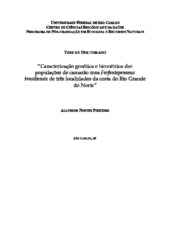Caracterização genética e biométrica das populações de camarão rosa Farfantepenaeus brasiliensis de três localidades da costa do Rio Grande do Norte
Abstract
Shrimp catch is one of the main fishing activities in the world, mostly for the high value of commercialization reached by shrimp meat. Biological characteristics of penaeids make this group of shrimps aspirant to show different levels of population structure. Penaeid species like Farfantepenaeus brasiliensis are dependent of the estuary to complete its life cycle. Thus, the aim of this work was to evaluate if populations of F. brasiliensis, from the coast of Rio Grande do Norte, are structured by morphometrical and molecular analysis. Several measurements (Lt, Lc, La and weight) were recorded for each specimen. Divergence between places has been evaluated by univariate (ANOVA) and multivaried (Discriminant Analysis) techniques. FSTAT and GENEPOP were used to get the molecular levels of genetic variability in each population, as well as, comparisons between populations. The frequentist and bayesian methods were used to detect migrants in GENECLASS software. The results of the 3 morphometric analysis pointed out differences between sex-ratio in all analyzed localities. These results probably are related with differences in growth rate between sex and/or spatial stratification. Significant morphometric differences were obtained between populations by the univariate and multivaried methods. These differences could be consequence of the estuary necessity to complete the life cycle in F. brasiliensis. Likewise, local differences could contribute for these results. Females were more divergent among different areas than males. This result also could be a reflex of the biological characteristics of this species, due to the great relation between the spawning places and the females. The interval between insemination and spawning in shrimp females can be of 10 to 20 days. The molecular results showed medium levels of genetic variability in the analyzed localities. When compared with other species from the same family Ho varied between 0,471 and 0,540. The FST values did not showed genetic structure. However, these results could reflect the low number of analyzed loci, or the predominance of females in the samples, a characteristic inherent of the penaeids. The procedure used to detect migrants did not support the existence of migrants among evaluated populations; however some individuals had been excluded from all populations, probably belonging to other populations not sampled. In such a way, the set of results obtained, plus the biological characteristics of this species, and the distinct environmental characteristics among areas allow us to infer an existence of at least two F. brasiliensis stocks in Rio Grande do Norte coast.
